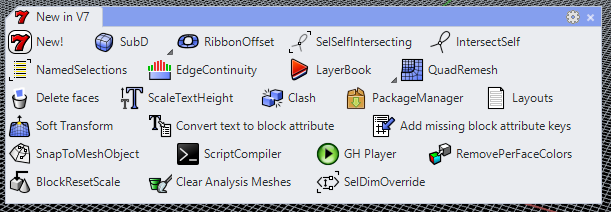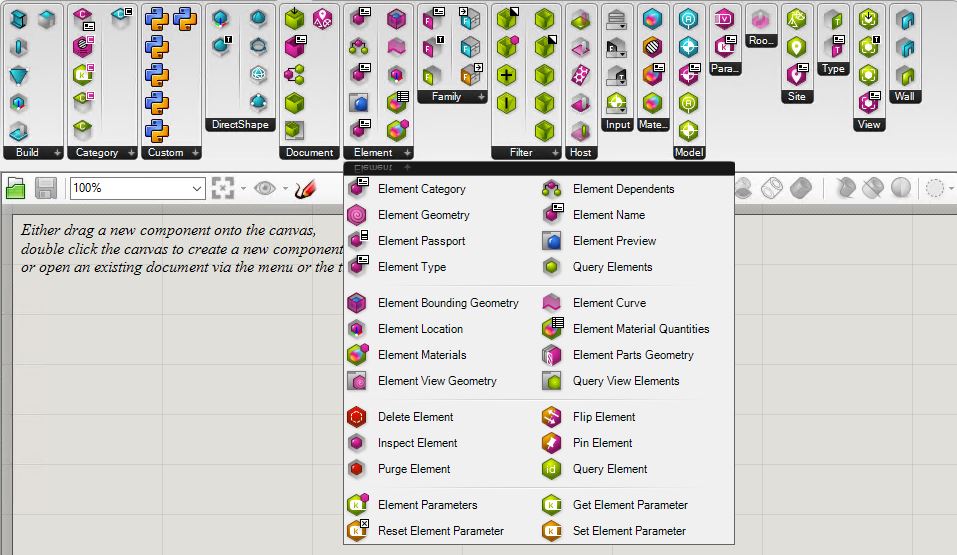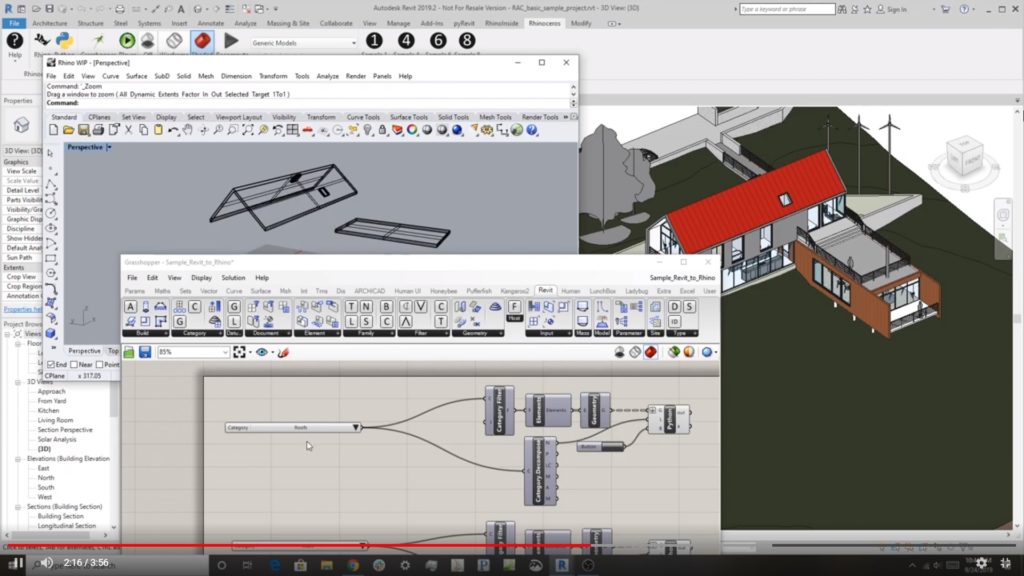As of April 30, 2025, we’re proud to announce our exciting new chapter. | Read more here.
The release of Rhino 7 is the most significant in the 30 years since Rhinoceros3D was first introduced. At its heart, RhinoCommon offers a powerful geometry engine with high mathematical accuracy, and with new features like SubD modeling and Clash Detection, it is only getting better.
If you haven’t already purchased a license of Rhino 7, I hope that by the end of this article you are convinced that it provides huge value out-of-the-box and great potential in the future.
Rhino3d.com/7/new/ lists all of the new features and capabilities of Rhino 7. For ease of navigating, links to some of the best features are listed below:
Explore organic shapes quickly and easily
Rhino 7 can now be used as a plugin for Autodesk Revit, expanding the possibilities for both programs. More info below…
Quickly create a Quad Mesh from existing geometries, including SubDs
Detect and resolve clashes quickly.
Installing and managing plugins for Rhino+GH is now easier than ever, right from Rhino itself!
Grasshopper was packaged as part of Rhino 6, and now with the GH Player, Plugins can be built to receive User Defined Inputs without the need to open and run the Grasshopper definition.
From Enhanced Text Fields that work with Formulas to Layout Management tools, it is easier than ever to document your designs
A full list of all of the new Commands that are available. For quick reference and similar to past versions, there is a tab called New in V7 which has some of the best new commands.

In addition to all of these new and enhanced features that come with Rhino 7, there is much effort afoot to bring the capabilities of Rhino into almost any environment (Rhino.Inside).
The foundations of Rhino are ready for broader and deeper applications of its capabilities. As plugins for Rhino have been developed over the years, it has spurred a thriving developer community with advanced tools for data and geometry manipulation.
In Version 6, Rhino was made into a Dynamic Link Library (DLL), which allowed for a couple of things to happen in the development of Rhino 7:
Rhino Compute lets Rhino run on a .NET Web Server, effectively bringing Rhino to the cloud. Startups such as Hypar are working to bring Grasshopper scripting and much more to the web browser, allowing for design input to come from anyone, anywhere.
The most popular flavor of the Rhino.Inside technology is Rhino.Inside.Revit (beta, free), which has effectively made Rhino 7 the largest possible plugin for Revit. Not only is it the full version of Rhino running within Revit’s memory space, but all of the plugins are compatible with Rhino 7 as well. Plugins that had been developed for Rhino 6 remain compatible, so the functionality that is part of many scripts and workflows can endure.
There are new Grasshopper Components found in V7, with the majority available within Rhino.Inside.Revit, in the Revit Tab.

For more information on Rhino.Inside.Revit Technology, please refer to our other blog posts and our Microsol Resources’ Youtube Channel for additional resources and webinar recordings.
Rhino 7 provides a framework with minimal barriers to entry. From the lone wolf coder to the multi-national firm, Rhino 7 can be very powerful if leveraged properly. A great conversation with Steve Baer, Luis Fraguada, and Will Pearson of Robert McNeel & Associates can be found on ProArchitect’s Youtube page. They discuss the rationale and forward-thinking concepts behind Rhino 7 and the Rhino.Inside technology, but for the most part, opine on Rhino Compute.
Want to upgrade to Rhino 7 or have any questions about any of the New Features? Feel free to contact us at rhino@microsolresources.com.
McNeel has developed a new technology that allows Rhino 7 to run in pretty much any Windows Application, with open-source developments underway for Unity, AutoCAD, and even Revit, enabling seamless access to the API and model data. This new capability is called Rhino Inside. It means that Rhino/Grasshopper can now be used inside Revit as a direct plug-in.
To try Rhino.Inside.Revit you will need Rhino 7 installed along with Rhino.Inside.Revit Beta, which is the Add-on for Revit. Rhino.Inside Revit allows you to link both platforms and avoid all need to import or export geometry. This creates an unprecedented integration between these applications. It is now possible to:
In typical McNeel style, the technology was quietly uploaded to GitHub to be tested and to see what the community thought of it. Through requests from testers, the feature set grew and it’s really only been this summer that McNeel folks and Microsol Resources have been openly presenting it in public.
Rhino 8 is here! Have any questions about any of the new features? Check out this article.
To get an introduction of Rhino.Inside and hear from those early testers of its capability, check out the following videos:
Have you ever wondered how to get Rhino models into Revit? Watch this introductory video by Scott Davidson from McNeel about one of Rhino’s 7 new technology: Rhino.Inside Revit, a project that allows you to access Rhino and Grasshopper core functionalities from within another application; in this case, Autodesk Revit and learn where to find the information and how to install it.
Watch how to transfer information from Rhino to Revit, creating Revit objects from Rhino geometry. See how editing objects in Rhino affects its counterparts in Revit, through this live link without any need to import or export! (3’41“)
In this video, you will learn how to transfer geometry from Revit into Rhino. This is a common workflow used for manufacturing purposes or for 3D printing the model. (3’56”)

In this video, Scott Davidson will show how to use parameters in Revit through Rhino’s generative design plugin, Grasshopper. You’ll also learn how to use Human UI, a Grasshopper plugin, to create your own dialog boxes that can interact with Autodesk Revit. (5’31“)
Watch this video to learn how to reference Revit elements using Grasshopper parameters and output Revit objects. You can edit these objects in Revit and have the Grasshopper freeform geometry update accordingly. (4’10”)
Revit.Inside is a work in progress but is already generating a lot of excitement among its target user base. It opens up a whole new level of integration between the McNeel ecosystem of applications and Revit data.
Rhino 8 is here! Have any questions about any of the new features? Check out this article. Ready to upgrade to Rhino 8 to have access to Rhino.Inside? Feel free to contact us at rhino@microsolresources.com.
McNeel’s Rhino 6 and Chaos Group’s compatible V-Ray for Rhino upgrade are now available. We’ve gathered below a few of Rhino 6’s latest features:
Interested in upgrading or getting a new Rhino 6 license? Want to upgrade your V-Ray for Rhino seat? Contact us at info@microsolresources.com today!
 |
The latest V-Ray for Rhino now supports Rhino 6.2 and above. Chaos Group has also implemented overall improvements to make your rendering workflow faster, smoother and more productive. |

Features the latest informative and technical content provided by our industry experts for designers, engineers, and construction firms and facility owners.
LEARN MORESTAY IN TOUCH